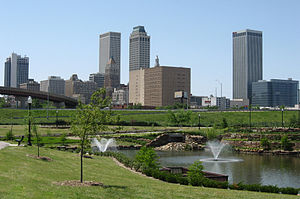Inola, Oklahoma
- Inola is also a spider genus (Pisauridae).
Inola, Oklahoma | |
|---|---|
| Nickname: Hay Capital of the World | |
Location of Inola, Oklahoma | |
| Coordinates: 36°08′53″N 95°31′29″W / 36.14806°N 95.52472°W | |
| Country | United States |
| State | Oklahoma |
| County | Rogers |
| Area | |
• Total | 6.75 sq mi (17.47 km2) |
| • Land | 6.68 sq mi (17.30 km2) |
| • Water | 0.07 sq mi (0.18 km2) |
| Elevation | 574 ft (175 m) |
| Population (2020) | |
• Total | 1,890 |
| • Density | 283.02/sq mi (109.27/km2) |
| Time zone | UTC-6 (Central (CST)) |
| • Summer (DST) | UTC-5 (CDT) |
| ZIP code | 74036 |
| Area code(s) | 539/918 |
| FIPS code | 40-37100[3] |
| GNIS feature ID | 2412794[2] |
| Website | http://www.inolaok.com |
Inola is a town in Rogers County, Oklahoma, United States. It is included in the Tulsa Metropolitan Statistical Area (TMSA). The population was 1,788 at the 2010 census with a 12.5 percent increase from 1,589 at the 2000 census.[4] Inola is a Cherokee word meaning "Black Fox."[5] The town styles itself as "The Hay Capital of the World."[6]
History
[edit]In 1889, the Kansas and Arkansas Valley Railway (later acquired by the Missouri Pacific Railway) built a line from Wagoner through the Foyil area onto the Kansas state line. The area was then just inside the northeastern corner of the Creek Nation in Indian Territory. A post office was established in March 1890 with the name Foyil. It was closed in September 1890 but reopened in April 1891. By 1901, the population was estimated at 100 people. The Dawes Commission had the town platted in 1902, before the Creek allotment.[5]
Strip mines began producing coal nearby before statehood in 1907, causing a small boom in population. Inola's population was 405 in 1920. As the coal industry began to decline, so did the town's population. The 1930 census reported only 399 residents. The decline continued through the post World War II era, reaching 294 in 1950. A turnaround began in the 1950s as residents began commuting to Tulsa. Inola's population grew to 584 in 1960 and 984 in 1970. The 1980 census showed 1,550 residents, increasing to 1,589 in 2000 and 1,788 in 2010.[5]
Geography
[edit]According to the United States Census Bureau, the town has a total area of 6.6 square miles (17 km2), of which 6.5 square miles (17 km2) is land and 0.1 square miles (0.26 km2) (0.91%) is water.
Demographics
[edit]This section needs expansion. You can help by adding to it. (July 2015) |
| Census | Pop. | Note | %± |
|---|---|---|---|
| 1910 | 405 | — | |
| 1920 | 498 | 23.0% | |
| 1930 | 398 | −20.1% | |
| 1940 | 395 | −0.8% | |
| 1950 | 294 | −25.6% | |
| 1960 | 584 | 98.6% | |
| 1970 | 948 | 62.3% | |
| 1980 | 1,550 | 63.5% | |
| 1990 | 1,444 | −6.8% | |
| 2000 | 1,589 | 10.0% | |
| 2010 | 1,788 | 12.5% | |
| 2020 | 1,890 | 5.7% | |
| U.S. Decennial Census[7] | |||
Economy
[edit]The town has emerged as a bedroom community for Tulsa, about 28 miles to the west.[5]
In October 2020, tissue paper maker Sofidel opened a $360 million production factory in Inola.[8] The 1.8 million-square-foot plant includes a mill that transforms pulp into paper and a conversion facility that makes the finished product.[8] The factory employs more than 300 people, and this number is expected to double with a second operational phase.[8]
Black Fox Power Plant
[edit]The Black Fox Nuclear Power Plant was a nuclear power plant proposed by the Public Service Company of Oklahoma (PSO) in May 1973. The facility was to be built approximately 3 miles (4.8 km) outside of Inola and encompass the use of two General Electric (GE) Boiling Water Reactors. PSO argued that there would be great economic growth and better schools in the town. Many residents as well as outsiders were convinced that it would be dangerous to locate such a facility in their backyards. After nine years of court battles and minor earthquakes in the area, the decision was abandoned in 1982 and no complex was built.[5]
References
[edit]- ^ "ArcGIS REST Services Directory". United States Census Bureau. Retrieved September 20, 2022.
- ^ a b U.S. Geological Survey Geographic Names Information System: Inola, Oklahoma
- ^ "U.S. Census website". United States Census Bureau. Retrieved January 31, 2008.
- ^ MuniNetGuide: Inola, Oklahoma.[1] Archived October 7, 2012, at the Wayback Machine.
- ^ a b c d e Larry O'Dell, "Inola" Encyclopedia of Oklahoma History and Culture Accessed March 19, 2012.[2] Archived November 19, 2012, at the Wayback Machine
- ^ "Inola: A Country Way of Life". Inola Chamber of Commerse. Archived from the original on June 18, 2008. Retrieved June 26, 2008.
- ^ "Census of Population and Housing". Census.gov. Retrieved June 4, 2015.
- ^ a b c "Tissue paper manufacturer Sofidel formally announces opening of plant in Inola". Tulsa World, October 6, 2020. Retrieved October 6, 2020.

